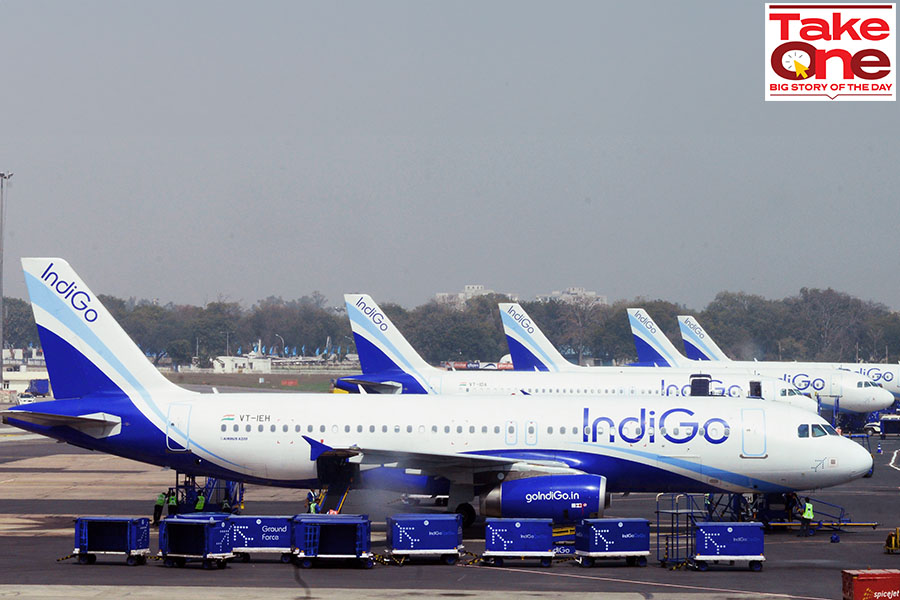
Can anything stop IndiGo?
The country's largest airline by market share reported its highest ever profit for a quarter. Revenues are at an all-time high as well. With a record order book and lean operation model, it is now gunning for more
 IndiGo has 316 aircraft and is awaiting the delivery of a record 1,330 aircraft from Airbus, making it the world’s biggest A320 family customer.
Image: Ramesh Pathania/Mint via Getty Images
IndiGo has 316 aircraft and is awaiting the delivery of a record 1,330 aircraft from Airbus, making it the world’s biggest A320 family customer.
Image: Ramesh Pathania/Mint via Getty Images
IndiGo is on a remarkable flight path, one that no other airline in India has taken so far.
On August 2, the country’s largest airline by market share reported its highest-ever profit for a quarter when it announced its April-June quarter results. The Gurugram-headquartered airline’s net profit stood at a staggering Rs3,089 crore against a loss of Rs1,056.5 crore in the year-ago period. Revenues, meanwhile, swelled to Rs17,160 crore during the quarter, its highest ever.
In all, the airline which has a staggering 63 percent market share in the domestic market, has cash worth Rs27,400 crore in its coffers, up by over 40 percent from Rs19,069.4 crore last June. On last count, the airline has 316 aircraft and is awaiting the delivery of a record 1,330 aircraft from Airbus, making it the world’s biggest A320 family customer.
“The IndiGo results, including the Rs3,090 crore profit, and 18 percent profit margins, are commendable,” says Satyendra Pandey, managing partner of aviation advisory AT-TV. “However, they are not reflective of the health of the industry which continues to suffer. Structural issues remain and as of now, there are two airlines in bankruptcy court and another airline in a significantly weakened state. All airlines except IndiGo are incurring losses.”
That means, by the looks of it, there is just no stopping IndiGo from here on. With a record order book, a lean operation model—barring some ATR aircraft, IndiGo’s fleet comprises one kind of aircraft helping reduce costs—and service spread over 75 domestic destinations and 25 international routes, the airline is only gunning for more as the domestic market consolidates.
India’s airline market has emerged into something of a duopoly, led by IndiGo and Air India, with the two airlines cornering nearly 90 percent of the market. In June, IndiGo had a market share of 63.2 percent. The Air India group had a domestic market share of 25.8 percent. On international routes, Air India has a 23 percent market share, while IndiGo has 15.78 percent.
“The figures correspond to the global trend we are seeing, with the post-Covid recovery showing little signs of easing,” says Shukor Yusof, founder and primary analyst at Malaysia-based aviation consultancy Endau Analytics. “It also reflects IndiGo's dominance in the Indian market. The one main concern is the 1.2 percent decline in yields, especially during a period of relatively ‘low’ fuel cost. It means IndiGo can’t fully extract the surge in demand.” Yield or revenue earned per paying passenger flown per kilometre was Rs5.18 per km.
IndiGo’s return to the black during the quarter also comes at a time jet fuel, which accounts for over 40 percent of the operational cost, has seen a steady decline since January. Then, by May, Go First, which had a market share of about 8 percent, folded up, and IndiGo, with its extensive market share, snapped up passengers.
Also read: IndiGo has beaten Air India to the mother of all aviation deals. Now, the rivalry is getting real
How’s it looking for IndiGo?
For now, there doesn’t seem to be any imminent threat to IndiGo’s market position. Much of that, of course, is because the competition just can’t seem to step up to IndiGo’s might, including the Tata group. “Air India is not yet in a position to threaten IndiGo,” adds Yusof. “Air India will need more time—at least two to three years—to mount a realistic challenge.”Air India is looking to replicate IndiGo’s success in its timely performance, staff behaviour, and a young fleet as it looks to stage a turnaround in its fortunes. The Tata group, which took over the airline after decades of government control, is also planning to take on IndiGo with free meals, entertainment, and frequent flyer programmes, which could take away flyers due to the value proposition.
“What its [Air India] end game is really about is the integration of Air India with Vistara in the full-service space, and on the other hand, the streamlining of products in the low-cost space with AirAsia India and Air India Express,” Vinamra Longani, head of operations at Sarin & Co, a law firm specialising in aircraft leasing and finance had told Forbes India earlier. “That will be challenging for the likes of IndiGo because it will look at mixing and matching the low-cost carrier with the international operations, which bring a lot of money, and coupled with loyalty programmes and connecting smaller cities to the international route will make it a formidable player.”
In addition, Air India has been improving its foreign network, especially in North America and Europe, and its recent order of more than 70 wide-bodied aircraft, including Airbus A350 and Boeing 787 and 777, are aimed at enhancing its international operations. On the domestic front, with the merger between Air India and Vistara, and another between Air India Express and AirAsia India, the Tata group wants to create a full-service carrier and a low-cost carrier under its umbrella.
“It's IndiGo's market to lose,” adds Shukor. “No other Indian carrier can match its low-cost operations and strong operational economics.”
Yet, the airline has a distinct advantage in the domestic market. The airline has pioneered the sale and leaseback model for many years. In a sale and leaseback model, an airline acquires the aircraft and sells them to a lessor, before leasing it back for use. The sale is usually at a profit and helps with cash.
India is expected to add over 2,200 aircraft over the next 20 years, according to Boeing, which will require enormous investments into infrastructure, training, and MRO (maintenance, repair, and operations). “India will need 31,000 more pilots and 26,000 mechanics to fly and maintain all those airplanes,” Boeing India’s president Salil Gupte had told Forbes India recently.
India’s domestic passenger traffic growth is estimated to grow between 8 percent and 13 percent in the current fiscal to reach 150 million, while international passenger traffic for Indian carriers is likely to grow between 10 percent and 15 percent, according to credit rating agency ICRA. Yet, losses continue to haunt the industry, which was hit hard by the Covid-19 pandemic. In the ongoing fiscal, losses of India’s airlines are expected between Rs5,000 crore and Rs7,000 crore, according to ICRA.
“The next few quarters will continue to be strong and international operations will help adjust the revenue mix and also the quality of demand,” says Pandey. “In the next few years, it is very likely that IndiGo will open an overseas base and position a significant number of aircraft. New subsidiaries also cannot be ruled out.”
“InterGlobe Aviation’s (IndiGo) fleet management has been its absolute bedrock in building a successful cost-efficient airline operation,” ICICI Securities wrote in a recent report. “The key elements of IndiGo’s successful fleet strategy are ordering well in advance to ensure continuous increase in capacity along with benefits of associated cash flow, maintaining low-cost structure driven by the consistency of uniform and fuel-efficient fleet composition and maintaining operations on single-aisle aircraft fleet despite the strategy of increasing international mix to 30 percent over the next two years and 40 percent by this decade from 23 percent in FY23.”
Also read: We had set ourselves a task no airline in the 120-year history of global aviation had ever done: Vinay Dube
Small challenges still around
About 40 aircraft of the airline are grounded due to engine troubles that had also haunted Go First before it shut down operations. However, IndiGo with its mighty fleet size, has been able to tide over the disruption. Then, over the past six months, the airline had been hit by a flurry of tail strikes before the country’s aviation watchdog (DGCA) sprung to action with an audit, before imposing a Rs30 lakh fine on the airline.“IndiGo will have to deal with the tyranny of size, and this can surface in several ways,” adds Pandey of AT-TV. “For now, it maintains a healthy lead and has the right product market fit. The challenge will be to consistently deliver on what matters to consumers while keeping a strict control on costs.”
Then, there are the potential troubles that could arise from quickly ramping up international operations, as IndiGo has been doing for a few years now. Earlier this month, the airline announced its Mumbai-Nairobi operation, marking its foray into the African continent, while also preparing to fly to destinations such as Tbilisi, Almaty and Tashkent. Rumour mills are abuzz about another likely purchase from IndiGo, this time for a few wide-bodied aircraft, typically used for long-haul flights.
“Going international will inevitably compromise on future earnings as the cost of operations will rise,” adds Yusof. Yet, despite all that, IndiGo’s prospects only look brighter, considering the enormous underlying potential for travel in India which has once again emerged as the world’s fastest-growing large economy. Much of this is driven by a growing middle class and rising disposable income that tends to be spent on travel.
In the process, air fares in the country are only expected to further grow, leading to some windfall for the likes of IndiGo which dominate the market. “It is a mixed bag for the Indian consumer,” adds Pandey. “While she or he will inevitably pay higher fares, there is also an argument that it's better to have fewer-but-stronger airlines which then translates into reliability, network and product offerings.”
For IndiGo, the flight path is only getting clearer and better. If anything, there are some tailwinds to help too.


















